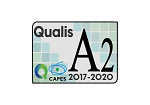Comparação da categoria cognitiva e da estrutura de uma palavra polissemântica
DOI:
https://doi.org/10.29051/el.v8iesp.3.17446Palavras-chave:
Polissemia, Categoria cognitiva, Categorização linguística, Significado, Invariante lexicalResumo
Este estudo procura analisar o fenômeno da polissemia correlacionado com a organização conceitual das categorias cognitivas, sendo a estrutura polissemântica uma categoria de natureza prototípica. Uma análise de componentes invariantes de cada um dos significados figurativos e ainda comparando-os com a semântica do primeiro significado nominativo-não-derivativo são utilizados para atender aos objetivos do estudo. Os achados da pesquisa de categorização linguística de objetos da realidade com a identificação de um conjunto de traços centrais, segundo os quais uma palavra é atribuída a uma determinada categoria, leva à extrapolação dos resultados da pesquisa para as estruturas de palavras polissemânticas. O artigo mostra que tanto os membros da categoria de sujeito cognitivo quanto os significados figurativos da polissemântica são orientados para os métodos de categorização conceitual e linguística do mundo real, e ambos são voltados “para dentro” em sua própria estrutura.
Downloads
Referências
Blank, A. (2003). Polysemy in the lexicon and in discourse. Trends in linguistics studies and monographs, 142, 267-296.
Cavazzana, A., & Bolognesi, M. (2020). Uncanny resemblance: Words, pictures, and conceptual representations in the field of metaphor. Cognitive Linguistic Studies, 7(1), 31-57.
Evans, V., Bergen, B. K., & Zinken, J. (2015). The cognitive linguistics enterprise: An overview (pp. 2-36). Equinox.
Franco, K. (2022). What Cognitive Linguistics can learn from dialectology (and vice versa). Data Analytics in Cognitive Linguistics: Methods and Insights, 41, 309.
Górska, E. (2019). Understanding Abstract Concepts Across Modes in Multimodal Discourse: A Cognitive Linguistic Approach. Routledge.
Gouteraux, P. (2017). Lexical complexity: Metaphors and collocations in native, non-native and bilingual speech. Proceedings 3, Louvain-la-Neuve: Presses universitaires de Louvain, 363, 384.
Hurtienne, J. (2017). How cognitive linguistics inspires HCI: image schemas and image-schematic metaphors. International Journal of Human–Computer Interaction, 33(1), 1-20.
Kiseleva, S., & Trofimova, N. (2017). Metaphor as a device for understanding cognitive concepts. Revista de Lenguas para Fines Específicos, 23(2), 226-246.
Jingkun, Z. H. A. O. (2022). Metaphor, Metonymy and the Extension of the Meanings of Polysemous Words. Studies in Literature and Language, 24(1), 19-27.
Mirgalimova, L. M., Arsenteva, E. F., & Nikulina, E. A. (2020). Deviation of phraseological unit semantic stability as a means of phraseological transformation. International Journal of Criminology and Sociology, 9, 2638-2644.
Pan, M. X. (2019). The effectiveness of the Conceptual Metaphor Approach to English idiom acquisition by young Chinese learners. Metaphor and the Social World, 9(1), 59-82.
Pesina, S. A., Vinogradova, S. A., Kiseleva, S. V., Trofimova, N. A., Pastushkova, M. A., & Ovcharenko, N. V. (2021). Functional aspects of indeterminacy category and invariant study of polysemous words. Revista EntreLinguas. https://doi.org/10.29051/el.v7iesp.8.16357
Pesina, S. A., Yusupova, L. G., & Pulekha, I. R. (2019). Anthropomorphism in language studied through the prism of embodiment. Вестник Челябинского государственного университета, 10 (432), 223-227.
Quilty‐Dunn, J. (2021). Polysemy and thought: Toward a generative theory of concepts. Mind & Language, 36(1), 158-185.
Van der Merwe, C. H. (2021). Biblical Hebrew and cognitive linguistics: a general orientation. New Perspectives in Biblical and Rabbinic Hebrew, 641.
Downloads
Publicado
Como Citar
Edição
Seção
Licença

Este trabalho está licenciado sob uma licença Creative Commons Attribution-NonCommercial-ShareAlike 4.0 International License.
Os manuscritos aceitos e publicados são de propriedade da Revista EntreLínguas. Os artigos publicados e as referências citadas na Revista EntreLínguas são de inteira responsabilidade de seus autores.
Transferência de direitos autorais – autorização para publicação
Caso o artigo submetido seja aprovado para publicação, já fica acordado que o(s) autor(es) autoriza(m) a UNESP a reproduzi-lo e publicá-lo na EntreLínguas, entendendo-se os termos “reprodução” e “publicação” conforme definição respectivamente dos incisos VI e I do artigo 5° da Lei 9610/98. O artigo poderá ser acessado pela rede mundial de computadores (Internet), sendo permitidas, a título gratuito, a consulta e a reprodução de exemplar do artigo para uso próprio de quem a consulta, desde que haja a citação ao texto consultado. Essa autorização de publicação 328 EntreLínguas, Araraquara, v. 1, n .2, p. 323-328, jul./dez. 2015 não tem limitação de tempo, ficando a UNESP responsável pela manutenção da identificação do(s) autor(es) do artigo. Os artigos publicados e as referências citadas na Revista EntreLínguas são de inteira responsabilidade de seus autores.










